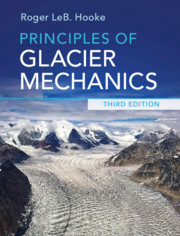Book contents
- Principles of Glacier Mechanics
- Reviews
- Principles of Glacier Mechanics
- Copyright page
- Dedication
- Contents
- Preface to the third edition
- Preface to the second edition
- Preface to the first edition
- Physical constants relevant to ice
- Derived SI units and conversion factors
- 1 Why study glaciers?
- 2 Some basic concepts
- 3 Mass balance
- 4 Flow and fracture of a crystalline material
- 5 The velocity field in a glacier
- 6 Temperature distribution in polar ice sheets
- 7 The coupling between a glacier and its bed
- 8 Water flow in and under glaciers: Geomorphic implications
- 9 Stress and deformation
- 10 Stress and velocity distribution in an idealized glacier
- 11 Numerical modeling
- 12 Applications of stress and deformation principles to classical problems
- 13 Ice streams and ice shelves
- 14 Finite strain and the origin of foliation
- 15 Response of glaciers to climate change
- 16 Ice core studies
- Problems
- References
- Index
7 - The coupling between a glacier and its bed
Published online by Cambridge University Press: 20 December 2019
- Principles of Glacier Mechanics
- Reviews
- Principles of Glacier Mechanics
- Copyright page
- Dedication
- Contents
- Preface to the third edition
- Preface to the second edition
- Preface to the first edition
- Physical constants relevant to ice
- Derived SI units and conversion factors
- 1 Why study glaciers?
- 2 Some basic concepts
- 3 Mass balance
- 4 Flow and fracture of a crystalline material
- 5 The velocity field in a glacier
- 6 Temperature distribution in polar ice sheets
- 7 The coupling between a glacier and its bed
- 8 Water flow in and under glaciers: Geomorphic implications
- 9 Stress and deformation
- 10 Stress and velocity distribution in an idealized glacier
- 11 Numerical modeling
- 12 Applications of stress and deformation principles to classical problems
- 13 Ice streams and ice shelves
- 14 Finite strain and the origin of foliation
- 15 Response of glaciers to climate change
- 16 Ice core studies
- Problems
- References
- Index
Summary
Where a glacier bed is at the pressure melting point, ice moves past rigid obstacles by a combination of regelation and plastic flow. Equations can be written to describe the sliding speed due to these two processes when the ice is clean. Clastic debris and impurities decrease the speed. Basal ice commonly contains debris, liquid impurities, and liquid water on crystal boundaries. Thus, it is rheologically different from ice higher in the glacier. Water in cavities in the lee of bumps on the bed is commonly under pressure, and acts as a hydraulic jack, increasing the flow rate. Clasts gripped in basal ice moving over bedrock abrade the bed. Where a layer of till is present between the ice and the bedrock, the till may deform, increasing the glacier flow rate. Till obeys the classic Mohr-Coulomb failure criterion, but once it begins to deform, the deformation rate increases rapidly with stress, as in a perfectly plastic substance. Factors that control the depth of deformation in till are not well understood. Ice may regelate downward into till; this is a possible mechanism of till entrainment. Deformation of subglacial till may lead to the formation of drumlins and flutes.
- Type
- Chapter
- Information
- Principles of Glacier Mechanics , pp. 149 - 198Publisher: Cambridge University PressPrint publication year: 2019



